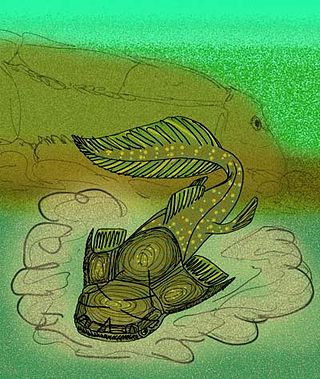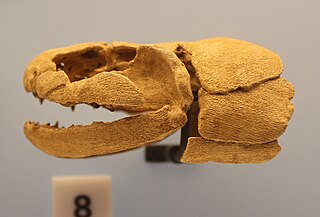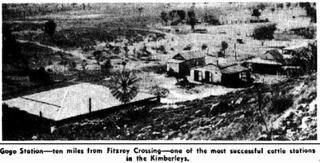
The Devonian is a geologic period and system of the Paleozoic era during the Phanerozoic eon, spanning 60.3 million years from the end of the preceding Silurian period at 419.2 million years ago (Ma), to the beginning of the succeeding Carboniferous period at 358.9 Ma. It is named after Devon, South West England, where rocks from this period were first studied.

Placoderms are vertebrate animals of the class Placodermi, an extinct group of prehistoric fish known from Paleozoic fossils during the Silurian and the Devonian periods. While their endoskeletons are mainly cartilaginous, their head and thorax were covered by articulated armoured plates, and the rest of the body was scaled or naked depending on the species.

Tetrapodomorpha is a clade of vertebrates consisting of tetrapods and their closest sarcopterygian relatives that are more closely related to living tetrapods than to living lungfish. Advanced forms transitional between fish and the early labyrinthodonts, such as Tiktaalik, have been referred to as "fishapods" by their discoverers, being half-fish, half-tetrapods, in appearance and limb morphology. The Tetrapodomorpha contains the crown group tetrapods and several groups of early stem tetrapods, which includes several groups of related lobe-finned fishes, collectively known as the osteolepiforms. The Tetrapodomorpha minus the crown group Tetrapoda are the stem Tetrapoda, a paraphyletic unit encompassing the fish to tetrapod transition.

Phyllolepida is an extinct taxon of flattened placoderms found throughout the world, with fossils being found in Devonian strata. Like other flattened placoderms, the phyllolepids were bottom-dwelling predators that ambushed prey. Unlike other flattened placoderms, the phyllolepids were inhabitants of freshwater environments.

Gogonasus was a lobe-finned fish known from three-dimensionally preserved 380-million-year-old fossils found from the Gogo Formation in Western Australia. It lived in the Late Devonian period, on what was once a 1,400-kilometre-long coral reef off the Kimberley coast surrounding the northwest of Australia. Gogonasus was a small fish reaching 30 to 40 centimetres in length.

Brindabellaspis stensioi is a placoderm with a flat, platypus-like snout from the Early Devonian of the Taemas-Wee Jasper reef in Australia. When it was first discovered in 1980, it was originally regarded as a Weejasperaspid acanthothoracid due to anatomical similarities with the other species found at the reef.

Rolfosteus is an extinct monospecific genus of arthrodire placoderm from the Early Frasnian stage of the Late Devonian period, found at the Gogo Formation of Western Australia.

Onychodus is a genus of prehistoric lobe-finned fish which lived during the Devonian Period. It is one of the best known of the group of onychodontiform fishes. Scattered fossil teeth of Onychodus were first described from Ohio in 1857 by John Strong Newberry. Other species were found in Australia, England, Norway and Germany showing that it had a widespread range.

The Gogo Formation in the Kimberley region of Western Australia is a Lagerstätte that exhibits exceptional preservation of a Devonian reef community. The formation is named after Gogo Station, a cattle station where outcrops appear and fossils are often collected from, as is nearby Fossil Downs Station.

Diplocercides is an extinct genus of marine coelacanth which lived during the Late Devonian period. It is the only confirmed member of the family Diplocercididae (=Diplocercidae), although some studies classify other genera such as Nesides, Chagrinia, and Euporosteus in it as well.

Incisoscutum is an extinct genus of arthrodire placoderm from the Early Frasnian Gogo Reef, from Late Devonian Australia. The genus contains two species I. ritchiei, named after Alex Ritchie, a palaeoichthyologist and senior fellow of the Australian Museum, and I. sarahae, named after Sarah Long, daughter of its discoverer and describer, John A. Long.
Gogodipterus is an extinct genus of prehistoric marine lungfish in the family Chirodipteridae. It contains a single species, G. paddyensis, known from the Late Devonian Gogo Formation of Western Australia. It was formerly placed in Chirodipterus.

Ligulalepis is an extinct genus of stem-osteichthyans which lived from the Silurian to the Early Devonian. Ligulalepis was first described from isolated scales found in the Taemas-Wee jasper limestones of New South Wales by Hans-Peter Schultze (1968) and further material described by Burrow (1994). A nearly complete skull found in the same general location was described in Nature by Basden et al. (2000) claiming the genus was closely related to basal ray-finned fishes (Actinopterygii). In 2015 Flinders University student Benedict King found a more complete new skull of this genus which was formally described by Clement et al. (2018), showing Ligulalepis to be on the stem of all osteichthyans.

Fallacosteus is an extinct monospecific genus of arthrodire placoderm from the Early Frasnian stage of the Late Devonian period, found at the Gogo Formation of Kimberley, Western Australia. As with almost all other camuropiscids, F. turneri had an elongated snout that may have enhanced its hydrodynamic streamlining.

Tubonasus is an extinct monospecific genus of long-snouted arthrodire placoderm from the Early Frasnian stage of the Late Devonian period, found at the Gogo Formation of Kimberley, Western Australia.

The evolution of fish began about 530 million years ago during the Cambrian explosion. It was during this time that the early chordates developed the skull and the vertebral column, leading to the first craniates and vertebrates. The first fish lineages belong to the Agnatha, or jawless fish. Early examples include Haikouichthys. During the late Cambrian, eel-like jawless fish called the conodonts, and small mostly armoured fish known as ostracoderms, first appeared. Most jawless fish are now extinct; but the extant lampreys may approximate ancient pre-jawed fish. Lampreys belong to the Cyclostomata, which includes the extant hagfish, and this group may have split early on from other agnathans.

The Bokkeveld Group is the second of the three main subdivisions of the Cape Supergroup in South Africa. It overlies the Table Mountain Group and underlies the Witteberg Group. The Bokkeveld Group rocks are considered to range between Lower Devonian (Lochkovian) to Middle Devonian (Givetian) in age.
Torosteus is an extinct genus of arthrodire placoderm from the Early Frasnian stage of the Late Devonian period. Fossils are found in the Kimberley region of Australia.

Phoebodus is an extinct genus of phoebodontiform total group elasmobranch, known from over a dozen species found worldwide spanning the middle to late Devonian, making it one of the oldest known total group elasmobranchs. Most species are only known from their isolated tricuspid teeth, but one species, Phoebodus saidselachus from the Late Devonian of Morocco, is known from a complete skeleton, estimated to have been 1.2 metres (3.9 ft) in total length in life, which shows that it had a slender body superficially similar to that of the living frilled shark. The teeth of Phoebodus and frilled sharks are also morphologically similar, and are designed for grasping prey. Phoebodus probably consumed small prey items that were capable of being swallowed whole.





















